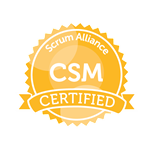Top 3 Reasons Companies Struggle with Agile and Scrum
 Agile, as a philosophy, has “crossed the chasm” as organizations seek to respond to dynamic market conditions and fickle, quality-focused customers. While every organization has certainly explored Agile methods to some extent, many continue to struggle with their application and implementation. In this blog, I will explore the top three reasons that these organizations are struggling and outline some ways that they can overcome these barriers to realize the benefits that they sought in first exploring Agile. These reasons and potential mitigation’s are as follows:
Agile, as a philosophy, has “crossed the chasm” as organizations seek to respond to dynamic market conditions and fickle, quality-focused customers. While every organization has certainly explored Agile methods to some extent, many continue to struggle with their application and implementation. In this blog, I will explore the top three reasons that these organizations are struggling and outline some ways that they can overcome these barriers to realize the benefits that they sought in first exploring Agile. These reasons and potential mitigation’s are as follows:
1.) Lack of Understanding of What Agile/Scrum Means
The rise in popularity of Agile and the most prominent Agile method, Scrum, means that many people have encountered both terms either within their organization, on the web, in a book, or at a conference. While these tangential exposures are beneficial, they can result in people not fully understanding or comprehending what both can mean to an organization.
Moreover, the simplicity of Scrum can compound this phenomenon. The entire Scrum Framework is comprised of three roles, three artifacts and four events and can be depicted on a single page. While the Framework itself is simple, its execution against the backdrop of a Company’s current culture (see below) and product development process can prove much harder.
2.) Culture
The methods that comprise “Agile” will not solve any issue that currently exists within an organization’s culture or “the way most of the people behave most of the time”. Issues of distrust, lack of accountability, respect, or courage are all readily exposed by Agile methods such as Scrum. For example, Scrum’s focus on producing a potentially releasable product increment in each sprint may expose the broader organization to both the lack of quality practices within software engineering as well as the “technical debt” from past product development efforts that has not been paid off.
Most organizations are not prepared to deal with these issues surfacing and, without a neutral party to facilitate their exploration and resolution, most organizations simply ignore them or blame Agile/Scrum for creating them. Ken Schwaber, one of the co-founders of Scrum, states that Scrum holds a mirror up to the organization. When that mirror reflects back something an Organization does not like, the Organization blames the “mirror” instead of looking at the feedback provided objectively and determining how to address it.
3.) Not “Using As Directed”
Most Agile methods are “framework-based”. This means that they provide the minimal set of roles, artifacts and ceremonies necessary to create a product on a frequent basis. These methods, Scrum included, allow people who adopt them to add things to the framework that they find useful. For example, a number of teams often leverage practices from Extreme Programming (XP) like Continuous Integration or Pair Programming. These additions are welcomed as they are part of becoming the self-organizing teams that Scrum advocates.
However, many organizations take this freedom to mean that they can compromise on the simple set of practices that Scrum advocates. A company may make the decision, “Yes – Scrum talks about the need for a Product Owner who is decisive, knowledgeable and available to the team, but no one has the time to fill that role so we will just skip it. After all, Scrum states that it’s a framework”. So the company moves forward in adopting what it calls “Scrum” without identifying a Product Owner. As they struggle, they fail to see that the reason they are not realizing the benefits from Scrum is that they are not practicing it in the first place.
A key step that organizations can take to ensure that they don’t struggle with Agile, and more specifically Scrum, is to invest in well-trained, dedicated ScrumMasters. A ScrumMaster is a neutral, servant leader who seeks to not only serve a Team by facilitating them through the Scrum framework, but seeks to teach the organization how they can maximize the value from the Scrum Framework.
Interested in learning more about how this role can help an organization achieve the benefits that it is seeking from Agile? Please join me for Certified Scrum Master (CSM) training at Watermark Learning on June 15th and June 16th.
You can also learn more about becoming certified as a ScrumMaster on the Scrum Alliance website.
Innovative, servant leader with extensive IT experience and a passion for process improvement. Demonstrated leadership improving team performance in the midst of significant organizational change. Positive, team-oriented management style achieving results through systematic analysis, collaboration and strong project management.
